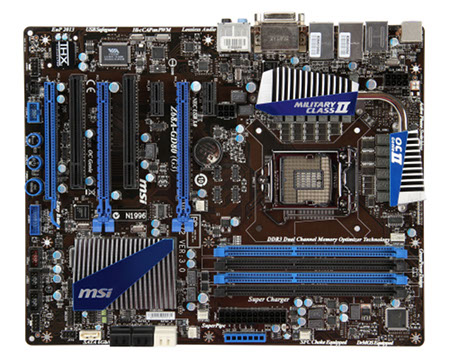PCI Express 3.0 debuts on ATX motherboard
Jul 7, 2011 — by LinuxDevices Staff — from the LinuxDevices Archive — 1 viewsMSI announced what it says is the world's first motherboard to offer PCI Express 3.0 expansion, for bandwidth up to 32GB/sec. The “Z68A-GD80” accepts “Sandy Bridge” Core processors, has seven expansion slots, includes 6Gb/sec. SATA and USB 3.0, and sports a BIOS that has a graphical user interface and supports 3TB drives, the company says.
MSI's new Z68A-GD80 is by no stretch of the imagination an embedded product, as features such as "THX TruStudio Pro" sound and an "OC Genie II" overclocking button make clear. However, it's worthy of attention since it appears to be the first product to feature PCI Express 3.0.
In August 2007, the PCI-SIG announced PCI Express 3.0 as the "next generation of PCI Express architecture," saying that this would double bandwidth while offering backward compatibility. According to the standards group, the new specification increases bus speed to 8GHz, compared to the 5GHz and 2.5GHz used by PCI Express 1.0 and 2.0, respectively.
PCI Express 3.0 also moves from the previous 8- and 10-bit data encoding schemes to 128-bit and 130-bit encoding, eliminating a 20 percent overhead. As a result of all this, it's claimed, PCI Express 3.0 has an effective bandwidth of 7.99GT/sec., rather than PCIe 2.0's maximum of 4GT/sec.
The PCI-SIG originally planned to debut the PCI Express 3.0 specification in 2009, but its release was delayed by more than a year due to extensive backwards-compatibility testing. When the spec finally emerged last November, the group noted that products based on it could achieve aggregate bandwidth approaching 32 GB/sec. on a sixteen-lane (x16) configuration.

MSI's Z68A-GD80 features PCI Express 3.0
(Click to enlarge)
The 32 GB/sec. speed is precisely what MSI is claiming for the two PCI Express 3.0 x16 slots on its new Z68A-GD80 (above), with the obvious expectation that they'll be used by gamers to drop in discrete graphics cards. The motherboard can drive its HDMI and DVI-D video outputs using the integrated graphics on the supported "Sandy Bridge" Core CPUs, but Lucidlogix Virtu technology ensures that AMD or Nvidia graphics cards are invoked when applications would benefit from them, MSI adds.
In addition to the overclocking utility mentioned earlier, other software frills offered by the motherboard include a BIOS that provides a graphical user interface and even touchscreen support. According to MSI, system settings may be controlled via a screen that looks much the same in Windows as it does before the Z68A-GD80 has booted.
MSI adds that its BIOS not only supports 3TB hard disk drives but can even use them as boot disks for a 64-bit operating system, implying that competing boards cannot pull off these feats. Also touted is Winki 3, a Linux-based OS that may be used to get online, plus the ability to back up the BIOS to (or restore it from) any USB flash disk.
The Z68A-GD80 supports LGA1155-socketed Core i3, i5, and i7 processors with Intel's recently announced Z68 Express chipset, plus four DIMM slots that accept up to 32GB of memory, according to MSI. The board includes four 3Gb/sec. SATA ports and two 6Gb/sec. SATA ports — with RAID 0/1/5/10 support — and also has an eSATA port on its back panel, the company adds.

The back panel on MSI's Z68A-GD80
(Click to enlarge)
In addition to the video outputs that have already been mentioned, the back panel (above) has two gigabit Ethernet ports, four USB 2.0 ports, two USB 3.0 ports, and a PS/2 port. Media-oriented additions include an IEEE 1394 port, an S/PDIF optical digital output, and six 3.5mm jacks for surround audio output.
On top of the board (seen earlier in this story), meanwhile, there are not only two PCI Express 3.0 x16 slots, but also one PCI Express 2.0 x16 slot, two PCI Express x1 slots, and two 32-bit PCI slots, according to MSI. The Z68A-GD80 also provides headers for two more USB 2.0 connectors and another USB 3.0 port, the company adds.
Specifications listed by MSI for the Z68A-GD80 include:
- Processor — LGA1155-socketed Core i3, i5, or i7 (max. clock speed not cited)
- Chipset — Intel Z68
- Memory — up to 32GB of DR3 RAM via four DIMM slots
- Storage — 2 3Gb/sec. SATA ports, 2 6Gb/sec. SATA ports, 1 eSATA port
- Expansion:
- 2 x PCI Express 3.0 x16 slots
- 1 x PCI Express 2.0 x16 slot
- 2 x PCI Express x1 slots
- 2 x 32-bit PCI slots
- Networking — 2 x gigabit Ethernet
- Other I/O:
- HDMI
- DVI-D
- 7 x USB 2.0 (4 external, 3 internal)
- 3 x USB 3.0 (2 external, 1 internal)
- 1 x PS/2
- S/PDIF
- IEEE 1394
- audio — six 3.5mm jacks
- Power — ATX power supply; consumption n/s
- Dimensions — 12 x 9.6 inches
Further information
MSI did not release pricing for the Z68A-GD80, but the board appears to be available now. More information may be found on the Z68A-GD80 product page.
Jonathan Angel can be reached at [email protected] and followed at www.twitter.com/gadgetsense.
This article was originally published on LinuxDevices.com and has been donated to the open source community by QuinStreet Inc. Please visit LinuxToday.com for up-to-date news and articles about Linux and open source.